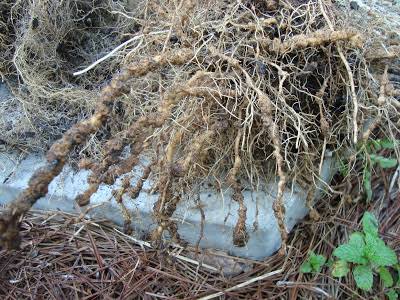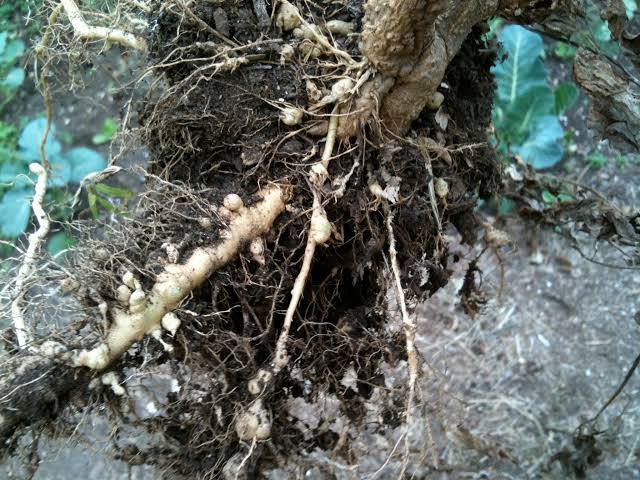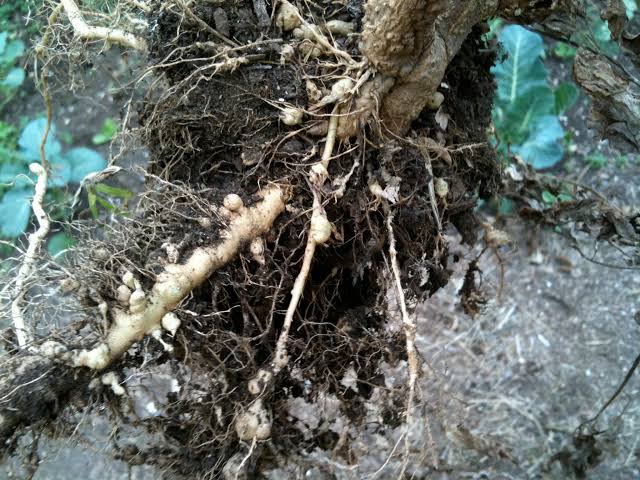Root-knot nematodes, scientifically known as Meloidogyne spp., are tiny roundworms that can cause significant damage to plants. These microscopic pests infect the roots of various crops, leading to stunted growth, reduced yields, and overall poor plant health.
These nematodes have a unique life cycle that involves several stages. The adult female nematodes lay eggs in a gelatinous mass on the roots of host plants. As the eggs hatch, juvenile nematodes emerge, penetrating the roots to feed on plant cells. This feeding activity induces the formation of characteristic swellings or galls on the roots, which are the hallmark symptom of a root-knot nematode infestation.
The impact of root-knot nematodes extends beyond the visible symptoms. The feeding process disrupts the normal functioning of plant roots, impeding their ability to absorb water and nutrients. This interference weakens the plant and makes it more susceptible to other stress factors, such as drought or diseases.
Crop losses attributed to root-knot nematodes are widespread and economically significant. Various crops, including vegetables, fruits, and ornamental plants, can fall victim to these nematodes. The damage they cause not only affects the quantity of the harvest but also the quality of the produce.
Farmers face considerable challenges in managing root-knot nematode infestations. Traditional control methods often involve the use of chemical nematicides, but these solutions can have environmental repercussions and may not always be sustainable. Integrated pest management strategies, which combine various approaches such as crop rotation, resistant plant varieties, and biological control agents, offer more sustainable alternatives.
Developing and deploying resistant plant varieties is a key aspect of mitigating the impact of root-knot nematodes. Researchers are working to identify and breed crops with natural resistance to these pests, offering a more environmentally friendly and cost-effective solution for farmers.
Additionally, root-knot nematodes pose a significant threat to agricultural productivity, affecting a wide range of crops. Understanding their life cycle and the resulting damage is crucial for implementing effective management strategies. Ongoing research into sustainable control methods and the development of resistant plant varieties are essential for ensuring food security and the long-term health of agricultural ecosystems.
Read Also: How to Farm and Care for Blue Swimming Crab (Portunus pelagicus)
Plants Affected by Root-knot Nematodes (Meloidogyne spp.)

Root-knot nematodes have a broad host range, affecting various plants across different plant families. Some of the commonly affected crops include vegetables, fruits, and ornamental plants. These nematodes can pose a considerable threat to agricultural productivity due to their ability to infest a wide range of plant species.
1. Tomatoes: Tomato plants are highly susceptible to root-knot nematodes. The nematodes can cause the formation of galls on the roots, leading to reduced nutrient uptake and stunted growth.
2. Potatoes: Root-knot nematodes can infect potato plants, affecting tuber development and overall yield. Infested plants may show signs of wilting and poor vigor.
3. Carrots: Carrot roots can be infested by root-knot nematodes, causing deformities and reducing the quality of the harvest.
4. Bell Peppers: Bell pepper plants are vulnerable to root-knot nematodes, leading to the development of galls on the roots and a decline in plant health.
5. Strawberries: Root-knot nematodes can impact strawberry plants, affecting their growth and fruit production.
6. Cucumbers: Cucumber plants may suffer from root-knot nematode infestations, resulting in stunted vines and decreased fruit yield.
7. Melons: Melon plants are susceptible to root-knot nematodes, leading to poor fruit development and overall plant weakness.
8. Citrus Trees: Root-knot nematodes can affect the roots of citrus trees, compromising their health and fruit production.
9. Beans: Certain types of beans, including common beans and soybeans, can be hosts for root-knot nematodes, impacting their growth and yield.
10. Ornamental Plants: Root-knot nematodes are not limited to edible crops; they can also infest the roots of various ornamental plants, affecting their aesthetic appeal and health.
The wide range of plants affected by root-knot nematodes underscores the importance of developing effective and sustainable management strategies to protect diverse crops from these damaging pests. Crop rotation, the use of resistant plant varieties, and other integrated pest management approaches play crucial roles in mitigating the impact of root-knot nematodes on agriculture.
Damages Caused by Root-knot Nematodes
Root-knot nematodes inflict significant damage to plants, impacting both the quantity and quality of agricultural yields. The damages caused by these microscopic pests are diverse and can severely affect the overall health and productivity of host plants.
1. Stunted Growth: One of the primary consequences of root-knot nematode infestations is stunted growth. The nematodes feed on plant roots, inhibiting normal root development and, consequently, restricting the overall growth of the plant.
2. Gall Formation: Root-knot nematodes induce the formation of galls or swellings on the roots of host plants. These galls result from the nematodes’ feeding activity, causing abnormal growth and disrupting the normal functioning of the root system.
3. Reduced Nutrient Absorption: The nematodes’ feeding on plant roots interferes with the plant’s ability to absorb water and essential nutrients from the soil. This disruption leads to nutrient deficiencies in the host plant, further exacerbating growth limitations.
4. Wilting and Yellowing: Infested plants often exhibit symptoms of wilting and yellowing. The compromised root system struggles to support the plant’s water and nutrient needs, resulting in visible signs of stress such as wilting foliage and yellowed leaves.
5. Decreased Yield: Root-knot nematode infestations can lead to a significant reduction in crop yields. The compromised root systems contribute to poor plant health, lower fruit or vegetable production, and overall diminished harvest quantities.
6. Poor Quality Produce: Beyond quantity, the quality of the produce can also be affected. Fruits and vegetables may be deformed, discolored, or exhibit other undesirable characteristics due to the nematode-induced damage to the plant’s root system.
7. Increased Susceptibility to Other Stress Factors: Plants infested with root-knot nematodes become more vulnerable to other stress factors, such as drought, diseases, and additional pest attacks. The weakened state of the plant makes it less resilient to environmental challenges.
8. Economic Impact: The economic impact of root-knot nematode damage is substantial. Crop losses and reduced quality can lead to financial losses for farmers, affecting livelihoods and food supply.
Addressing the damages caused by root-knot nematodes requires a comprehensive approach that includes integrated pest management strategies. These may involve crop rotation, the use of resistant plant varieties, and sustainable soil management practices to minimize the impact of these destructive pests on agriculture.
Read Also: How to Farm and Care for Pacific Sand Lance Fish (Ammodytes personatus)
Control and Preventive Measures

Effective control and preventive measures are crucial in managing root-knot nematode infestations, as these pests can cause significant damage to a wide range of crops. Implementing a combination of strategies is often more successful than relying on a single method. Here are key approaches to control and prevent root-knot nematode damage:
1. Crop Rotation: Rotate crops in the field to disrupt the nematode life cycle. Planting non-host crops for a specific period can help reduce nematode populations in the soil.
2. Resistant Plant Varieties: Select and plant crop varieties that are resistant or tolerant to root-knot nematodes. Breeding programs aim to develop crops with natural resistance, providing a sustainable and environmentally friendly solution.
3. Cover Crops: Planting cover crops, such as marigolds or certain grasses, can help suppress nematode populations. Some cover crops release compounds that are toxic to nematodes or provide unfavorable conditions for their survival.
4. Biofumigation: Certain plants, like mustard and brassicas, release compounds during decomposition that have nematocidal properties. Incorporating these plants into the soil as green manure can help manage nematode populations.
5. Organic Amendments: Adding organic matter to the soil can improve its structure and promote beneficial microbial activity. Well-rotted compost or manure can enhance soil health, making it less favorable for nematode development.
6. Nematicides: Chemical nematicides are available for nematode control, but their use should be approached with caution due to potential environmental impact. Integrated pest management considers the judicious use of nematicides when other strategies are insufficient.
7. Soil Solarization: This involves covering the soil with transparent plastic during hot months, using solar heat to raise soil temperatures and reduce nematode populations. This method is effective in areas with high temperatures and abundant sunlight.
8. Sanitation: Practice good field sanitation by removing and destroying infested plant debris. This helps prevent nematodes from completing their life cycle and reduces the likelihood of carryover from one growing season to the next.
9. Water Management: Maintain proper soil moisture levels to minimize stress on plants. Avoid overwatering, as excessively wet conditions can favor nematode proliferation.
10. Beneficial Microorganisms: Inoculate the soil with beneficial nematodes or other microorganisms that can prey on root-knot nematodes. This biological control approach can help maintain a balance in the soil ecosystem.
Implementing a combination of these measures, tailored to the specific agricultural context, can enhance the overall effectiveness of root-knot nematode control and prevention. Sustainable and integrated approaches contribute to long-term soil health and reduce the reliance on chemical interventions.
Frequently Asked Questions (FAQs) About Root-knot Nematodes (Meloidogyne spp.)
1. Q: What are root-knot nematodes?
A: Root-knot nematodes are microscopic roundworms that infest plant roots, causing galls or swellings and leading to stunted growth and reduced crop yields.
2. Q: What crops are commonly affected by root-knot nematodes?
A: Root-knot nematodes have a broad host range, affecting various crops such as tomatoes, potatoes, carrots, bell peppers, strawberries, cucumbers, melons, citrus trees, beans, and ornamental plants.
3. Q: How do root-knot nematodes damage plants?
A: Root-knot nematodes damage plants by feeding on their roots, causing galls, stunted growth, reduced nutrient absorption, wilting, yellowing, decreased yield, and poor quality produce.
4. Q: How can I identify root-knot nematode infestation in my plants?
A: Look for characteristic galls or swellings on the roots. Plants may exhibit wilting, yellowing, and poor growth. Soil tests and root examinations can confirm nematode presence.
5. Q: Can root-knot nematodes be controlled without using chemicals?
A: Yes, several non-chemical control methods exist, including crop rotation, planting resistant varieties, cover cropping, biofumigation, organic amendments, soil solarization, and beneficial microorganisms.
6. Q: Are there crops resistant to root-knot nematodes?
A: Yes, researchers are developing and promoting crops with natural resistance to root-knot nematodes. Planting resistant varieties is a sustainable approach to manage nematode infestations.
7. Q: Can root-knot nematodes be eliminated from the soil?
A: Complete elimination is challenging, but effective management strategies can reduce nematode populations. Crop rotation and soil amendments contribute to long-term control.
8. Q: Do root-knot nematodes only affect agricultural crops?
A: No, root-knot nematodes can also infest the roots of various ornamental plants, impacting their aesthetic appeal and overall health.
9. Q: How do I prevent the spread of root-knot nematodes between crops?
A: Practice good field sanitation by removing and destroying infested plant debris. Avoid moving soil from infested areas to uninfested ones to prevent spreading nematodes.
10. Q: Are there environmentally friendly methods to control root-knot nematodes?
A: Yes, using resistant plant varieties, cover crops, biofumigation, and beneficial microorganisms are environmentally friendly methods to control root-knot nematodes without relying on chemical treatments.
Read Also: Top 20 Key Principles Of Best Fitness

